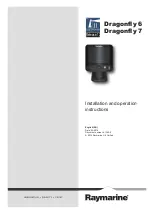
31
If the fish is detected using the narrow 200 kHz beam, the
display will show a filled-in symbol. If the fish is detected by
the
wide
50 kHz beam, the display will use a hollow symbol.
(For more on this, see “Choosing the Frequency.”)
Fish depth
This indicates the depth of the fish shown by the fish
symbol. This number will be shown using the same depth
units (feet, fathoms, or meters) you have selected on the
System Setup display. The fish depth indicator is turned off
when the fish symbol function is off.
Bottom of display
Bottom indication
This shows the bottom of the lake or sea. You can com-
pare this to the range depth shown in the lower right-hand
corner. (In this example, the checkered pattern shows the
unit is getting a strong echo return from the bottom. See
the information on the White Line feature in the Setup
Instructions.)
Range
The “range” is the maximum depth the unit is set to
measure. In this example, this is 100 feet. You can set the
range manually, or the FishFinder can do it automatically.
Bottom depth This is the depth of the bottom shown on the display. You
can select FT (feet), FA (fathoms), or M (meters) using the
System Setup display. If the FishFinder can’t tell how deep
the water is, the last known depth flashes on the display.
This will continue until the unit can see the bottom again.
Buzzer symbol
This symbol shows whether any of the alarms will use the
buzzer. There are three kinds of alarms: shallow, deep, and
fish. If one of these alarms is set, it will always present a
flashing symbol on the display. The Buzzer symbol shows
whether the alarms will also use the buzzer.
If the Buzzer setting in the System Setup display is on
(indicating that the buzzer is enabled for all of the alarms),
this symbol will appear filled.
Operating Instructions


































